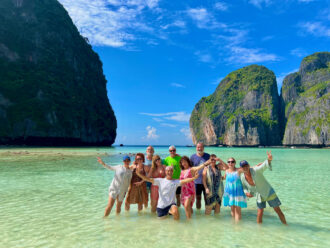In the digital age, the success of tourist destinations depends not only on their exotic landscapes or unique attractions but also on how they present themselves to the world. This is where tourism branding comes into play: an essential tool that allows destinations to emotionally connect with their visitors, from the first online search to the physical experience at the location. But how can a destination go from being just an image on a screen to becoming the paradise travelers desire? The key lies in an effective and authentic tourism communication strategy, supported by creative solutions that manage to win hearts.

The Power of Tourism Branding
Tourism branding goes far beyond a simple logo or catchy slogan. It involves building a clear and differentiated identity for a destination that resonates both in the minds and hearts of the target audience. For tourism marketing to be effective, it is crucial that destinations adopt a consistent narrative — a story that emotionally connects with travelers and invites them to live a unique experience.
Tourism communication strategies play a crucial role in this task, ensuring that a destination’s message not only reaches its target audience but does so in an authentic and memorable way. Authenticity is key to generating trust and loyalty among travelers.
Experiential Marketing: The Key to Emotional Connection
One of the most powerful trends in destination promotion is experiential marketing. Today’s travelers don’t just look for pretty pictures; they want experiences that make them feel something. This type of tourism content focuses on creating an emotional connection by showing travelers how they will feel when visiting the destination. It’s no longer just about physical attractions but about the emotions and memories visitors will take with them.
Digital marketing for tourism leverages this trend by using online platforms to tell visual stories through videos, social media, and interactive campaigns. In this way, the destination becomes an experience before the traveler even arrives, creating positive and emotional expectations that increase the desire to visit.
Tourism Communication Strategies to Differentiate Your Destination
For a tourist destination to stand out in a saturated market, it is essential to have strategic communication solutions. This is where differentiation comes into play. What makes your destination unique? What emotions or experiences does it offer that cannot be found anywhere else? Answering these questions is essential to develop an effective branding strategy.
Communication solutions must align with the destination’s values and characteristics. For example, a place promoting sustainable tourism should clearly communicate its commitment to environmental conservation and responsible practices. This will not only attract an increasingly environmentally conscious audience but also strengthen the destination’s reputation.
Tourism Promotion: Harnessing the Power of Social Media
Social media is an indispensable tool in modern tourism promotion. It not only allows reaching a global audience but also offers the possibility of interacting directly with travelers and generating user-generated content. Influencers, brand ambassadors, and visitors themselves can become powerful allies in spreading your destination’s story.
Tourism advertising on platforms like Instagram or YouTube is especially effective when combined with authentic and visually appealing content. Photos and videos of travelers enjoying unique experiences at the destination can be far more impactful than any traditional ad, as they show real experiences rather than just a promise.
Tourism Destination Management: Building a Lasting Relationship
An essential aspect of tourism branding is destination management. Attracting visitors is not enough; it is crucial that their experience is so memorable that they want to return and, even more importantly, recommend the destination to others. A destination’s reputation largely depends on the consistency in the quality of experiences it offers.
Tourist experiences must align with the expectations created during the promotion phase. If a destination has been presented as a relaxing and sustainable place, it is essential that the services and activities on site support that image. Otherwise, the visitor’s experience will be compromised along with the destination’s reputation.
Sustainable Tourism: An Opportunity to Win Hearts
Sustainable tourism is no longer an option but a necessity for many destinations seeking to attract conscious and responsible travelers. Sustainability must be an integral part of the tourism branding strategy, communicating not only what the destination has to offer but also how it is doing so responsibly.
Today’s travelers are increasingly demanding about the destinations they choose, preferring those that care about environmental conservation and local communities. Integrating sustainable practices into branding and tourism communication not only helps differentiate a destination but also creates a deeper and longer-lasting connection with travelers.

Conclusion: From Screen to Paradise
The transition from screen to paradise doesn’t happen by chance. It requires a well-thought-out and executed tourism branding strategy to win the hearts of modern travelers. From experiential marketing to destination management, every aspect must be aligned to create a coherent, authentic, and memorable experience.
In a world saturated with tourist options, destinations that effectively tell their story, offer unique and emotional experiences, and maintain a commitment to sustainability will be the ones that conquer not only the screen but also the hearts of travelers.

